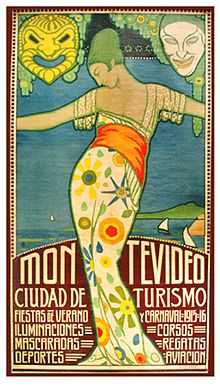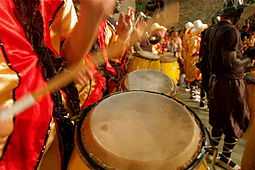Uruguayan Carnival
(Under construction)
| Uruguayan carnival | |
|---|---|
| Cultural origins | African, European |
| Typical instruments | Candombe drums |
| Subgenres | |
|
Candombe Beat, Murga, Comparsa, Revista, Uruguayan Carnival , Candombe  Montevideo Carnival in 1915 | |
| Regional scenes | |
| Uruguay Montevideo | |
Uruguayan Carnival is a popular festival that takes place every year in Uruguay from mid January to late February. It is related to candombe, Murga and tablados. It has evolved into a dance parade in which different comparsas play the drums and dance to the music at "Desfile Innaugural del Carnaval" and Llamadas parade. Uruguayan carnival can last up to 40 days and it involves a series of cultural events such as dance parades in the streets, street stages called "tablados" and an artistic contest at "Teatro de Verano" in Montevideo. [1]

History
Origins
Carnival in Montevideo

Sociedades de Negros y Lubolos
In Uruguay, las Sociedades de Negros y Lubolos, also called comparsas are a group of people who sing and dance to candombe music. The word lubolos makes reference to the white people that dresses as black people in the past in order to take part in the dance parades during colonial times in Uruguay. It consists of a group of dancers, a group of drummers named Cuerda de tambores and special characters such as La Mama Vieja, El escobero y El Gramillero [2]
Murga
Murga is a theatrical-musical genre that consists of a chorus of 14 to 17 people with murga drums. They sings songs and do some acting in between with impersonators and a mockery of events that criticizes politicians and society. People in murgas have their faces painted and usually are in bright outfits. Lyrical content is based on a particular theme, chosen by the group, which serves to provide commentary on events in Uruguay or elsewhere over the preceding year. Consequently, murga lends itself well to being used as a form of popular resistance. For example, during the dictatorship in Uruguay in the 1970s, groups like Araca La Cana became known for their left-wing tendencies, subversive commentary and oppositional stance.[3]
.jpg)
Humourists
It is a hilarious genre based on fiction scripts and it involves some singing, dance and recitations.
Parodists
"Parodistas"" They create funny situations called parodies, based on a well-known novel or film or even some famous character in history.
Revistas
They are a group of people dancing and singing pop music with different lyrics about human nature and personal problems.
External links
- Carnaval del Uruguay
- Portal de Murgas
- Carnaval del Futuro
- Carnaval de Montevideo: La mayor fiesta de la cultura y la participación popular
- http://www.daecpu.org.uy/